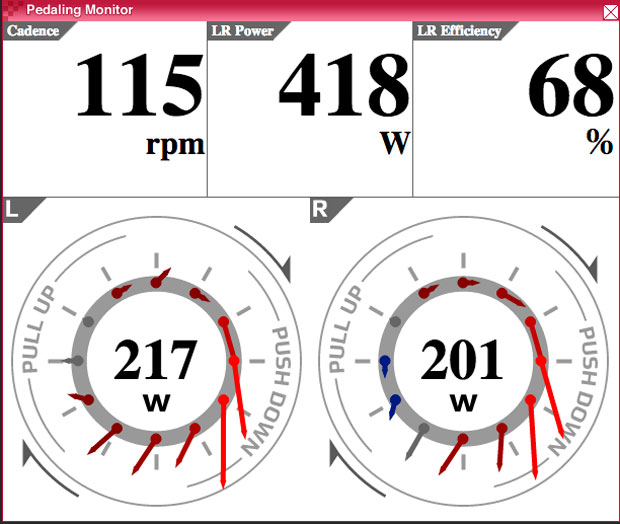I have been looking at the Cheung data and believe we can take more from it than the narrative of the text. Let's analyze this screen shot, when the rider is at high power.
One thing the author noted was a discrepancy in power between the right and left leg (here it is 217/201, a 7% difference) and he concludes this is a strength issue that can be fixed with isolated leg training strengthening the weak leg. Yet, my read of this data suggests the problem is not a leg weakness but a "technique" difference between the legs. The issue isn't that the right leg is weaker but the direction of the forces are less tangential in the right leg, especially when the forces are large and on the backstroke.
The magnitude and direction of the applied forces are essentially equal and tangential from 335º to 75º on the clock (there is the anomaly at 360º on the left but the magnitude of the force keeps the applied forward force about the same there) and little improvement could be achieved here (other than to increase the size of the applied forces). (Actually, I could argue that improvements could be made in these forces to improve efficiency but this is very nuanced and, I believe, beyond this discussion.)
But, when we get to 90º things start to change. The left leg forces are only about 10º off of tangential whereas the right leg force is about 25º off of tangential. This means the left leg is getting about 98% torque efficiency whereas the right leg is only getting about 90% torque efficiency - 8% less power for the right leg for essentially the same pushing force. This difference is maintained from 90º to 150º while pushing forces are a maximum. They return to being about the same at BDC. But, then we come to the upstroke. The left leg maintains positive power on the upstroke to 240º (and never goes negative) while the right leg never sees positive power again until 330º and has substantial negatives.
I think it is clear the difference in power seen between the right and left leg here has nothing to do with the right leg being weaker, as most people think of the term, but is purely a technique issue. In my opinion the technique of the left leg here has little room for improvement. If the technique of the right leg were the same this rider would be at 434 watts, a pick up of almost 5% in wattage from technique alone. Most riders don't come close to seeing the technique demonstrated by the left leg so most people have dramatically more potential improvement in them from paying attention to this detail.






